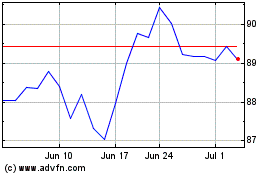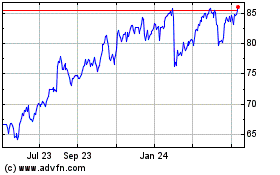Aflac Remaining Neutral - Analyst Blog
June 03 2011 - 1:46PM
Zacks
We reiterate
our recommendation on Aflac Inc.
(AFL) at Neutral, based on the
current sustainability factor. The company’s first quarter
operating earnings per share of $1.63 came in modestly higher than
the Zacks Consensus Estimate of $1.52 and $1.41 reported in the
year-ago quarter.
The growth
in the first quarter was supported by higher premium income, modest
investment yields, favorable dollar/yen exchange rate and
improvement in the U.S. operations, which also drove operating ROE.
However, higher claims and benefits due to the Japan
catastrophe, lower-than-expected top line and higher investment
losses partially negated the positives.
Nevertheless, Aflac’s strong brand name and solid business model
enabled it to improve earnings considerably faster than other life
and health insurers. Most significantly, the company is a prime
insurer in Japan in terms of individual policies in force. Japan’s
revenues accounted for 77% of the company’s total revenue in 2010,
73% in 2009, 72% in 2008 and 71% in 2007.
Aflac has been strengthening its Japanese operations
consistently that also helped itself survive the catastrophe
losses better than its peers. Besides, Aflac continued to be the
number one seller of cancer and medical insurance policies in Japan
throughout 2010.
In the US, the strategic acquisition of CAIC in 2009 has added
to Aflac’s product and distribution capabilities, which has started
reflecting in the company’s results. CAIC contribution has been
improving from 6% to 10.7% of the US sales production in 2010 and
first quarter of 2011, respectively.
With superior financial strength ratings and a new group product
platform, CAIC buyout is projected to be accretive to earnings in
the long run. However, loss of a large payroll account, persistent
lack of confidence from small businesses and fewer sales
associates cast a cautious outlook on the sales opportunities in
the U.S. in 2011.
Meanwhile, Aflac’s strong operating cash flow position (grew to
$7.0 billion in 2010 from $6.2 billion in 2009, $5.0 billion in
2008 and $4.7 billion in 2007) further enhances the company’s scope
for both inorganic and organic growth. Additionally, Aflac’s
National Association of Insurance Commissioners (NAIC) risk-based
capital ratio remained within 500% and 525% at the end of first
quarter of 2011.
Going ahead, this strong capital and surplus position is
expected to mitigate balance sheet risk and provide liquidity
cushion to its long-term growth. Regular dividend increment and
resumption of
the stock buyback program further validate Aflac’s efficient
capital deployment and fair liquidity. Meanwhile, Aflac also
aims to get rid of its problem investments in Europe through the
de-risking process, which is expected to last over the next 12–18
months.
Besides, Fitch Ratings upgraded its credit outlook on Aflac to
stable from negative in April 2011, while A.M. Best affirmed its
investment-grade debt ratings in May 2011, reflecting a stable
outlook based on Aflac’s present financial leverage that is
estimated to be around 23%, consistent with the rating category
criterion.
However, Aflac continues to be harshly hit by intense economic
volatility, the continued fluctuation of the yen against the
dollar, changes in interest rates, changes in credit spreads and
defaults, market liquidity and declines in equity price.
Although a slight improvement has been witnessed in the
yen/dollar exchange rate during the last couple of quarters, we
still remain cautious as the economic volatility will continue to
weaken the targeted earnings growth till markets rebound to
historical highs and provide buoyancy to exchange rates. Management
further ascertained this apprehension with a conservative
projection of a negative 2% to a positive 3% growth in Japan for
2011.
Despite the fact that Aflac is indulging in de-risking
activities, it is moving towards less risky
investments with lower yields, which will further lessen investment
income. Moreover, the company’s substantial exposure to European
financial institutions hybrid securities, below-investment-grade
debt and perpetual securities is likely to result in statutory
investment losses and lower reinvestment yields, thereby escalating
the financial and capital risk.
Increased
losses in the investment portfolio and lower income from the
variable annuity business is expected to continue to hurt
earnings at least in the near term, until the markets
witness a
steady recovery. Besides, the devastating earthquake and tsunami
that hit Japan in March 2011 have raised catastrophe losses and
weakened claims-paying ability. This is also reflected
in management’s estimation of earnings at the lower-end of the
guidance.
Overall, weighing all the pros and cons, we believe a stable
economy in the long run will gather momentum and negate interest
and currency risk, thereby providing more profitable investment
opportunities for Aflac.
AFLAC INC (AFL): Free Stock Analysis Report
Zacks Investment Research
AFLAC (NYSE:AFL)
Historical Stock Chart
From May 2024 to Jun 2024

AFLAC (NYSE:AFL)
Historical Stock Chart
From Jun 2023 to Jun 2024
